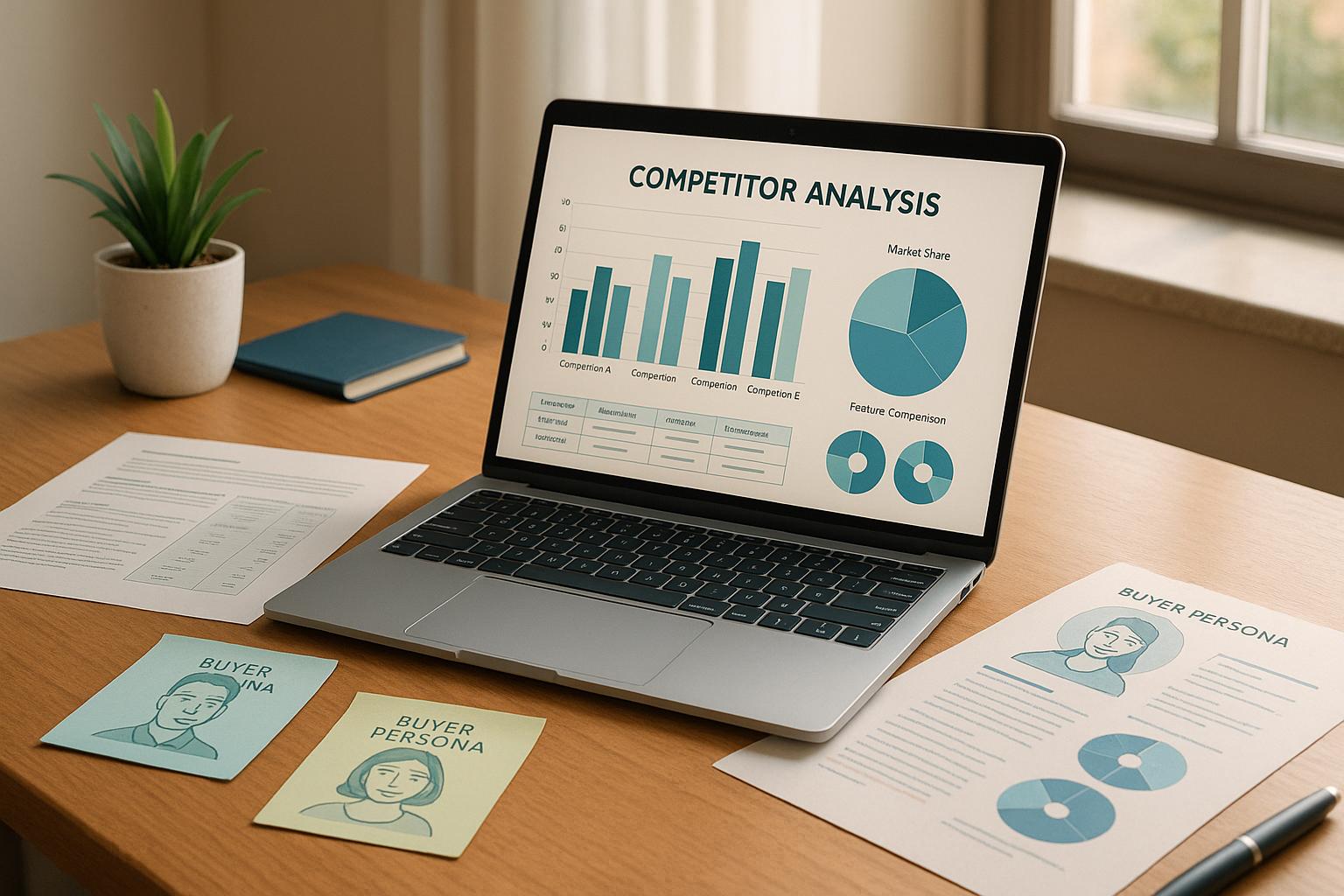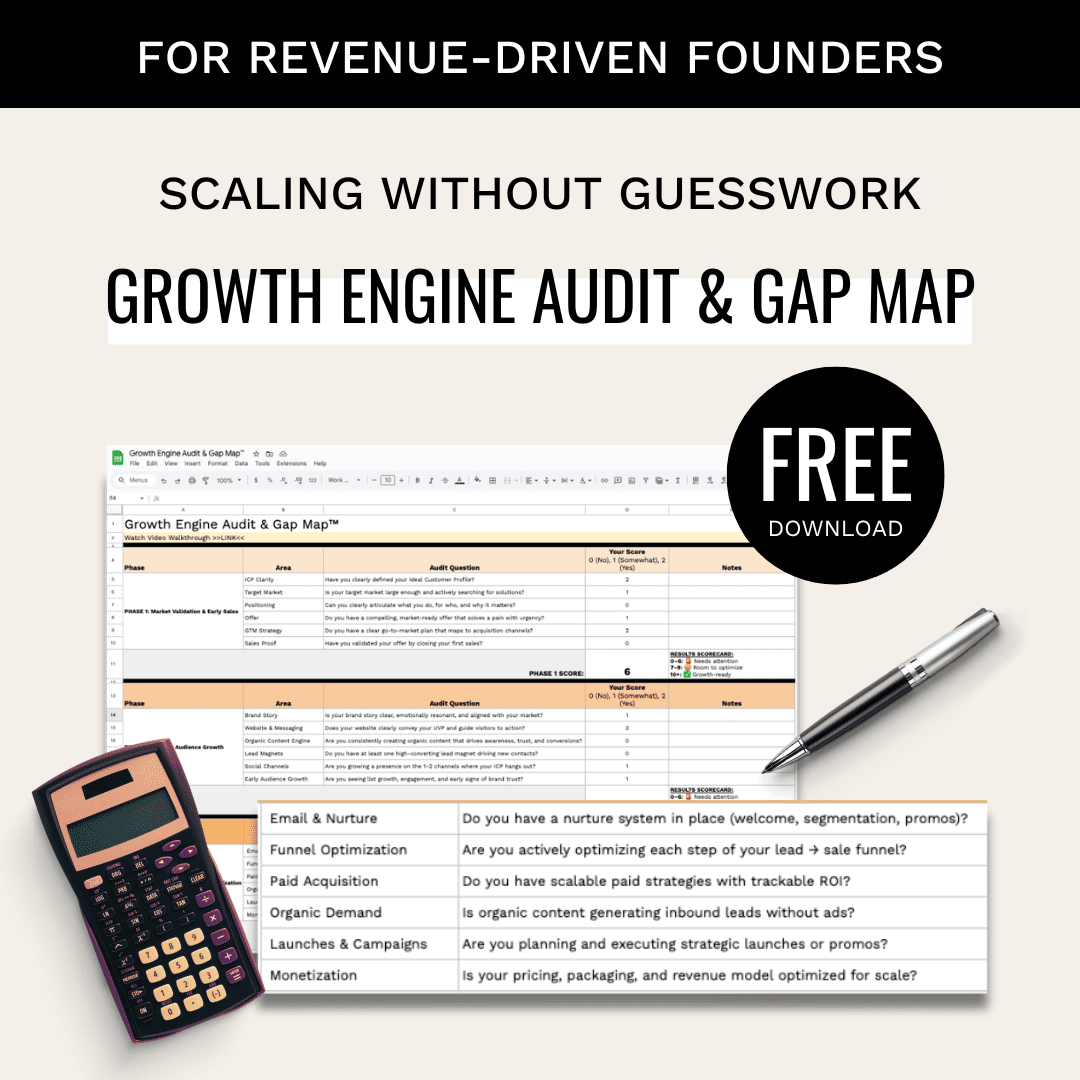Competitor analysis can improve your B2B marketing by helping you refine buyer personas and meet customer needs more effectively. Here’s a quick breakdown of the process:
- Why It Matters: Companies that use competitor insights can boost conversion rates by 42%. For example, a cybersecurity startup shifted focus to a new persona and saw demo requests increase 2.3x.
- Key Benefits: Shorter sales cycles, better lead quality, and faster revenue growth (up to 2.3x).
- How to Do It: Follow these 5 steps:
- Find Competitors: Identify direct, indirect, leading, and emerging competitors.
- Collect Data: Use tools like LinkedIn Sales Navigator, SEMrush, and G2 for insights on content, audience, and tech stacks.
- Review Market Position: Analyze competitor messaging, SEO, and content strategies.
- Build Competitor Personas: Study customer roles, industries, and buying processes.
- Apply Insights: Fill market gaps, refine messaging, and update personas quarterly.
Pro Tip: Companies refreshing personas every 90 days achieve 31% higher campaign relevance.
This guide shows you how to turn competitor research into actionable strategies for better B2B personas.
How To Do A Competitive Analysis [The Ninja 14-Step Framework]
Step 1: Find Your Main Competitors
Pinpointing your main competitors is a crucial step in refining B2B buyer personas.
Types of Competitors
To get a clear picture of your market, it’s important to look beyond just direct competitors. Here’s a breakdown of competitor types and how they contribute to persona research:
| Competitor Type | Definition | Impact on Persona Research |
|---|---|---|
| Direct Competitors | Businesses offering the same products or services | Highlights core buyer needs and preferences |
| Indirect Competitors | Companies with different solutions for the same audience | Helps identify broader customer challenges |
| Market Leaders | Industry giants with strong influence | Offers insights into effective audience targeting |
| Emerging Players | New, fast-growing companies | Sheds light on changing buyer behaviors |
How to Choose Which Competitors to Study
When narrowing down competitors to analyze, focus on those excelling in marketing and customer acquisition. Use these criteria to guide your selection:
- Market Performance: Look for high social media engagement, a visible thought leadership presence, and growing market share.
- Audience Similarity: Target competitors with overlapping customer demographics, similar industry focus, and comparable geographic reach.
- Marketing Success: Check for strong content engagement, effective lead magnets, and positive customer reviews or case studies.
Once you’ve identified the right competitors, the next step is to gather valuable insights using specialized tools.
Research Tools for Finding Competitors
The right tools can help you dig deeper into competitor strategies and performance. Here are some options:
| Tool Category | Primary Use | Key Benefits |
|---|---|---|
| LinkedIn Sales Navigator | Researching prospects and companies | Access to detailed firmographic data |
| SEMrush/Ahrefs | Analyzing keywords and content | Insights into competitor traffic |
| Crunchbase | Exploring company details | Information on funding and growth |
| G2/Capterra | Comparing products | User reviews and feedback analysis |
Using these tools effectively will help you map out the competitive landscape and build accurate B2B buyer personas.
Step 2: Collect Competitor Data
After identifying your competitors, the next step is gathering detailed data to refine your buyer personas.
Direct Research Methods
Take a deep dive into competitor websites and their online activity to uncover their targeting strategies. Focus on these key areas:
| Research Area | What to Look At | What You Learn |
|---|---|---|
| Website Content | Product pages, case studies, whitepapers | Industries they target, company sizes they focus on |
| Blog Articles | Topics, posting frequency, engagement levels | Customer pain points, their content approach |
| Social Media | LinkedIn posts, Twitter activity | How they interact with their audience, messaging patterns |
Combine this research with external feedback to get a more complete picture.
Third-Party Data Sources
Customer feedback from review platforms adds another layer of insight. Here’s where to look:
| Platform | What It Offers | How It Helps |
|---|---|---|
| G2 Crowd | Product reviews, satisfaction ratings | Understand customer preferences and common challenges |
| Capterra | User feedback, pricing details | Learn about budget priorities and decision-making factors |
Technology Stack Analysis
To go even deeper, analyze the tools and technologies your competitors use. This can help you better understand their operations and customer engagement strategies. Use platforms like BuiltWith to explore:
- Marketing Technology: Identify email marketing tools, CRM systems, and analytics platforms.
- Customer Support Tools: Look for chat software, ticketing systems, and help center solutions.
- Integration Options: Check for API connections and third-party integrations they rely on.
These insights not only sharpen your buyer personas but also give you a clearer picture of how competitors operate behind the scenes.
Step 3: Review Market Position
After identifying competitors and gathering data, it’s time to assess your market position. This step helps you understand what matters most to your buyers. By analyzing how competitors position themselves, you can fine-tune your B2B buyer personas.
Message Analysis
Take a close look at how your competitors communicate. This involves breaking down their key value propositions and messaging style. Focus on these key elements:
| Messaging Element | What to Analyze | Impact on Personas |
|---|---|---|
| Value Proposition | Key benefits and problem-solving tactics | Highlights customer pain points and goals |
| Success Stories | Testimonials and case studies | Offers real-world examples of results |
| Brand Voice | Tone, style, and complexity | Reflects the audience’s knowledge level |
| Industry Focus | Sector-specific communication | Points to target markets and key segments |
"Brand assessment and strategy development are crucial for identifying opportunities and building an evidence-based strategy." – Lillian Pierson
Once you’ve reviewed competitor messaging, see how it aligns with their SEO and content efforts.
SEO and Content Review
Dive into your competitors’ content strategies to uncover their keyword focus, distribution methods, and performance data. Here’s what to look for:
- Keyword Strategy Analysis
- Core keyword themes
- Organized content clusters
- Alignment with search intent
- Depth and expertise in content
- Content Distribution Patterns
- Platforms they prioritize
- Audience targeting methods
- Preferred content formats
- Content Performance Metrics
- Search engine visibility
- Social media engagement
- Sharing trends
- Levels of audience interaction
sbb-itb-e8c8399
Step 4: Build Competitor Persona Profiles
Developing competitor persona profiles helps uncover target audience traits and their decision-making processes.
Customer Characteristics
Use competitor data to shape detailed customer profiles. Here are some key data sources and how they can be applied:
| Data Source | Key Insights | How to Use It |
|---|---|---|
| Case Studies | Industry focus, company size, challenges solved | Pinpoint priority segments and common issues |
| Client Testimonials | Job titles, decision factors, implementation concerns | Understand what drives buyers and their objections |
| Social Media | Engagement trends, content preferences, topics of interest | Learn how customers communicate and what interests them |
| Professional Networks | Career paths, skills, organizational roles | Map out professional traits and expertise |
Dive into case studies, testimonials, social media activity, and professional networks to build detailed profiles. Pay attention to:
- Job Roles: Look for recurring roles in testimonials and case studies.
- Industry Focus: Identify the industries competitors target most often.
- Company Sizes: Note whether competitors focus on small businesses, mid-market, or large enterprises.
- Technical Complexity: Evaluate the sophistication of content and solutions offered.
Combine these findings with insights into the buying process to sharpen your marketing approach.
Buying Process Analysis
After building customer profiles, analyze how competitors’ customers make purchasing decisions. Focus on these key areas:
1. Decision-Making Units
Understand typical buying teams, including:
- Main decision-makers
- Technical evaluators
- Financial approvers
- End users
- Implementation teams
2. Stages of the Purchase Journey
Identify the types of content competitors use at each stage:
- Awareness: Educational materials to introduce solutions.
- Evaluation: Tools for comparing options.
- Decision: Content that validates the choice.
- Implementation: Resources that support onboarding and usage.
3. Stakeholder Engagement
Look at how competitors address the needs of key stakeholders, such as:
- IT teams focused on technical requirements.
- Financial decision-makers concerned with ROI.
- Department heads evaluating use cases.
- End users needing training and support.
Step 5: Apply Research Results
Once you’ve mapped out competitor personas, it’s time to use that information to fine-tune your market strategy.
Market Gap Analysis
Look for areas where competitors fall short. Are there customer needs they’re not addressing? Evaluate how well they deliver on technical requirements, service quality, pricing, and features. Build a framework to identify gaps by analyzing customer impact, competitor coverage, and potential opportunities. This will help you zero in on areas with the most growth potential.
Marketing Plan Updates
Revamp your marketing strategy to fill those gaps. Adjust your messaging and materials for each stage of the buyer’s journey. Match the tone and level of technical detail to what your personas need. Pay attention to the platforms, keywords, and content formats that resonate most with your audience.
Ongoing Research Methods
Keep tabs on competitors and market trends to stay ahead. Watch for updates on social media, new content, product launches, and industry news. Pay attention to shifts in how competitors position themselves and track emerging players and technology trends to keep your insights fresh.
Conclusion: Using Competitor Research Effectively
Competitor analysis plays a crucial role in shaping effective B2B personas. According to research, 89% of companies that implement structured competitor analysis see improved marketing ROI within six months. The trick is staying systematic while being flexible enough to adapt to market changes.
Focus on these three key metrics to enhance persona effectiveness:
| Metric | Target | Impact |
|---|---|---|
| Persona-Driven Conversion Rate | 15-20% improvement | Better lead quality |
| Content Engagement Rate | 30% increase | Stronger connection with the audience |
| Competitive Displacement Rate | 2.5x ROI | Growth in market share |
These metrics highlight the importance of keeping personas up to date. Refreshing personas quarterly can lead to a 2.3x quicker market response.
"Our analysis shows companies refreshing personas every 90 days achieve 31% higher campaign relevance scores than annual updaters", states the Data-Mania Tech Marketing Trends Report.
A well-rounded competitor research strategy blends technology analysis with traditional methods. For example, tools like BuiltWith can help you analyze competitors’ MarTech adoption patterns, uncovering trends in persona engagement. This approach enables businesses to spot gaps in competitors’ strategies and adjust their positioning to stay ahead.
To make the most of competitor research, successful teams dedicate 15-20% of their marketing analytics budget to developing dynamic personas. This investment supports the creation of flexible persona models that adapt to changing market conditions, resulting in more focused messaging and stronger market presence.
Competitor research is more than just data collection – it’s about turning insights into strategies that work. Teams that perform quarterly "Persona Health Checks" using a structured scoring system consistently outperform those relying on sporadic updates. This disciplined approach ensures that competitor insights directly contribute to a stronger buyer persona development process.
FAQs
How often should B2B companies update their buyer personas to keep marketing campaigns relevant and effective?
B2B companies should update their buyer personas at least once a year to ensure their marketing strategies stay aligned with evolving customer needs and market trends. However, if your industry is fast-paced or your target audience undergoes significant changes, consider revisiting and refining your personas more frequently – such as every 6 months.
Keep an eye on shifts in customer behavior, new competitors, and emerging technologies. Regular updates will help you maintain campaign relevance, improve targeting, and drive better results.
What are the best tools and techniques for conducting competitor analysis to refine B2B buyer personas?
To effectively gather competitor data for B2B buyer persona development, start by using tools like SEMrush, Ahrefs, and SimilarWeb to analyze competitors’ online presence, including traffic sources, keywords, and audience demographics. For social media insights, platforms like Hootsuite or Sprout Social can help track engagement trends and customer interactions.
Additionally, leverage LinkedIn for professional audience research and to identify key decision-makers within competitor companies. Combine these tools with direct methods such as reviewing competitors’ websites, case studies, and customer reviews to build a well-rounded understanding of their target personas. By integrating these insights, you can refine your own B2B buyer personas and stay ahead in the market.
How can analyzing competitors’ technology stacks and marketing strategies help refine B2B buyer personas?
Analyzing competitors’ technology stacks and marketing strategies can provide valuable insights into how they engage with their target audience. By understanding the tools and platforms they use, you can identify trends in customer preferences, uncover potential gaps in your own approach, and refine your B2B buyer personas to better align with market demands.
Additionally, examining their messaging, content, and outreach strategies can reveal what resonates with similar audiences. This helps you craft more targeted and effective personas, ensuring your marketing and sales efforts are more impactful and aligned with your business goals.
Related Blog Posts
- 5 Steps To Identify B2B Customer Pain Points
- 5 Best Practices for B2B Marketing Automation Success
- AI Lead Scoring: Basics for B2B Marketing
- Ultimate Guide to B2B Buyer Interviews




